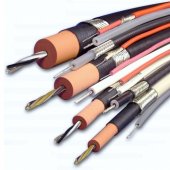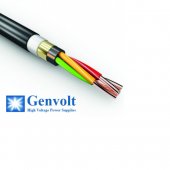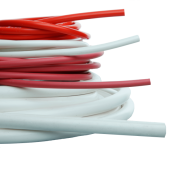Cable Terminology
To help your selection we have created a complete list of cable terminology for all of the high voltage cable that Genvolt supply.
Voltage The recommended maximum AC or DC voltage that may be continuously applied to a wire in conformance with its specifications. Some cables have been tested for operation above their rated voltage for a limited time period. For pulsed operation or insulating dielectric environments please contact us.
Impedance (OHMS) The average characteristic or surge impedance of a coaxial cable is determined by the ratio of the outer diameter of the inner conductor and by the dielectric constant of the insulating material between the conductors.
Capacitance The measurement of picofarads per metre, of the ability of a dielectric material to store electrical energy. Capacitance values for unshielded cables assume a uniform conductive surrounding.
Conductor Size AWG American Wire Gauge. The standard for copper wire sizes, specifying the diameter. The smaller the AWG number the larger the wire diameter.
Strands The first number signifies the number of wires in the conductor. The second number signifies the gauge size of the strand.
The letters following represent the type of plating on the copper conductor. TC –Tin Plated Copper, SPC –Silver Plated Copper, NPC –Nickel Plated Copper, BC –Bare Copper.
Square mm The metric measurement of copper in the conductor.
Diameter The outside diameter of the conductor in mm.
Semicon A semi-conducting material that has a resistance characteristic between that of insulators and conductors. When bonded between two elements of a cable, the adjacent surfaces of the two elements will maintain equal potential, providing uniform voltage stress, thus reducing internal corona. Semicon is used for both the inner conductor shielding and between the dielectric insulation and metallic shield.
Dielectric A non-conducting, insulating material with a dielectric constant, which is the ratio of capacitance of the material to the capacitance of air.
Material Specifies the type of compound used
EPR: Ethylene propylene diene monomer rubber
EPDM: Ethylene propylene diene monomer rubber
Hypalon: Chlorosulfonated polyethylene
LD: Low density
PVC: Polyvinyl chloride
PE: Polyethylene
TPR: Thermoplastic rubber
Diameter Outside dimension over dielectric in mm.
Rated Voltage The maximum DC voltage that can be applied between the centre conductor and inner shield.
Inner Shield A conducting layer or sheath of material applied around an insulated conductor or conductors to prevent extraneous electrostatic fields between the enclosed conductors and the external environment. Typical shields are constructed of a copper braid, metal tapes or conductive rubbers. Shields can also be used to provide return current paths.
Construction The AWG size of the individual strand in the braid with designation of plating on the strand.
AWG Equivalent The conductor size equivalent of the braid wires.
% Coverage The physical area of the cable covered by the shielding.
Intershield Insulation Specifies the type and thickness of non-conductive insulating material between the two shields.
Rated Voltage The maximum DC voltage that can be applied between the inner and outer shields.
Outer Shield The outer shield provides additional electrostatic shielding for low noise applications.
Jacket Material An outer sheath or protective covering over a conductor or insulation mainly used for protection against the environment, but may also be used to provide additional insulation.
Outside Diameter The measurement in mm of the finished cable.
Minimum Bend Radius The measurement of the flexibility of the finished cable determined by the strands in the conductor and the material used in the dielectric and jacket.
Part Number The four-digit part number characterises the basic core of the cable and can be followed by a suffix indicating the insulation jacket material or type of construction.
Minimum Ambient Temperature The measurement in degrees Celsius of the safe environmental operating temperature of the finished cable determined by the size and types of material in the cable.
Maximum Conductor Temperature The maximum operating temperature in degrees Celsius of the finished cable, determined by the size and types of material in the cable.
Weight The weight in kilograms per metre of the finished cable.




